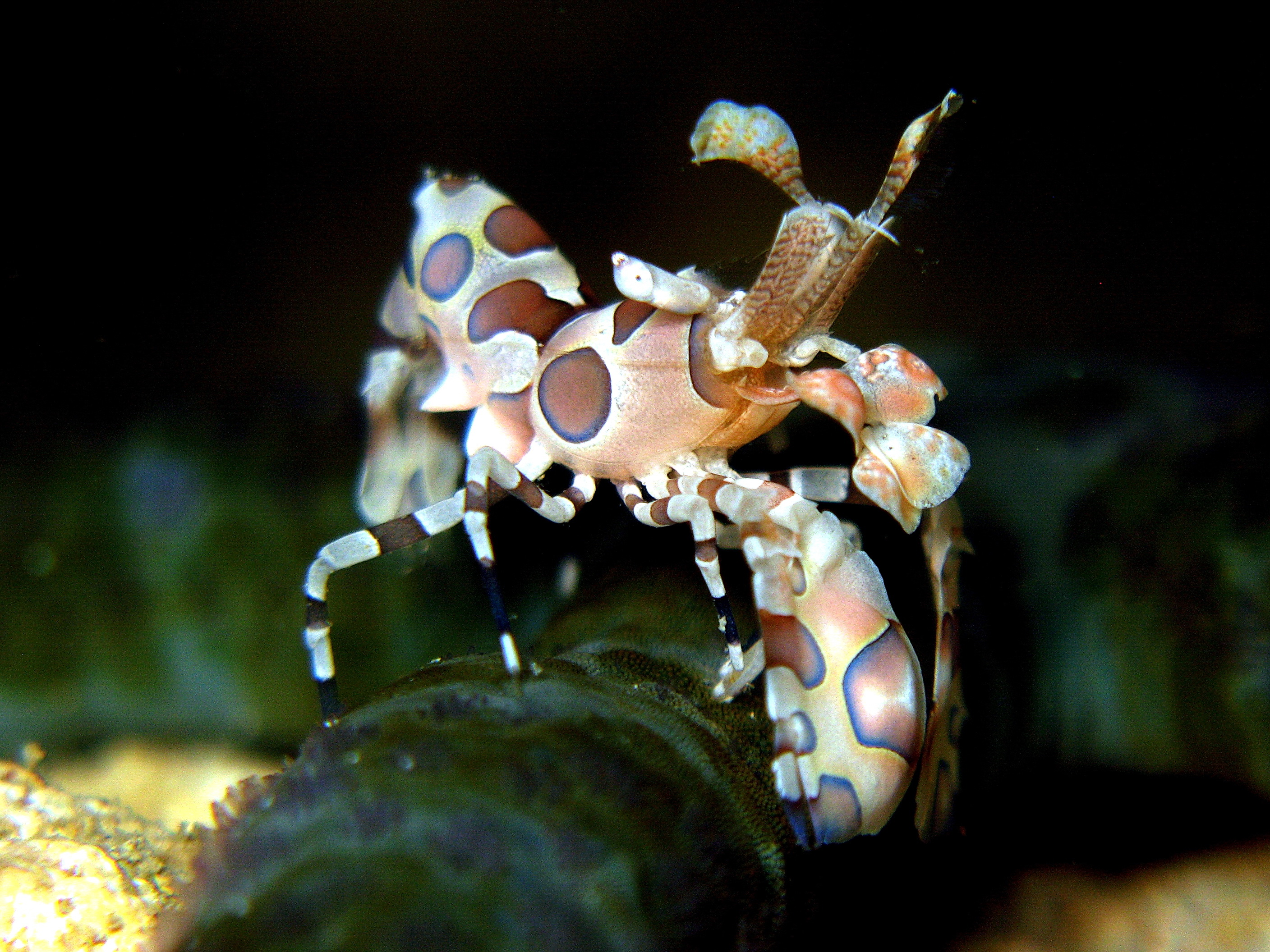Palaemonid on:
[Wikipedia]
[Google]
[Amazon]
 Palaemonidae is a
Palaemonidae is a
File:Bumblebee Shrimp.jpg, '' Gnathophyllum americanum''
File:Phyllognathia ceratophthalma (15688650415).jpg, Phyllognathia ceratophthalma, Phyllognathia genus
 Palaemonidae is a
Palaemonidae is a family
Family (from ) is a Social group, group of people related either by consanguinity (by recognized birth) or Affinity (law), affinity (by marriage or other relationship). It forms the basis for social order. Ideally, families offer predictabili ...
of shrimp
A shrimp (: shrimp (American English, US) or shrimps (British English, UK)) is a crustacean with an elongated body and a primarily Aquatic locomotion, swimming mode of locomotion – typically Decapods belonging to the Caridea or Dendrobranchi ...
in the order
Order, ORDER or Orders may refer to:
* A socio-political or established or existing order, e.g. World order, Ancien Regime, Pax Britannica
* Categorization, the process in which ideas and objects are recognized, differentiated, and understood
...
Decapoda
The Decapoda or decapods, from Ancient Greek δεκάς (''dekás''), meaning "ten", and πούς (''poús''), meaning "foot", is a large order of crustaceans within the class Malacostraca, and includes crabs, lobsters, crayfish, shrimp, a ...
. Many species are carnivores that eat small invertebrates, and can be found in any aquatic habitat except the deep sea. One significant genus is '' Macrobrachium'', which contains commercially fished species. Others inhabit coral reefs, where they associate with certain invertebrates, such as sponges, cnidarians, mollusks, and echinoderms, as cleaner shrimps, parasites, or commensals. They generally feed on detritus, though some are carnivores and hunt tiny animals.
The family contains more than 1200 species in 160 genera. The genera were formerly split into two subfamilies, but in 2015, molecular and morphological research determined that the subfamily groupings were invalid. At the same time, the members of the families Gnathophyllidae and Hymenoceridae were incorporated into the Palaemonidae.
Genera
The following genera are recognised: *'' Actinimenes'' *'' Alburnia'' *'' Allopontonia'' *'' Altopontonia'' *'' Amphipontonia'' *'' Anapontonia'' *'' Anchiopontonia'' *'' Anchistioides'' *'' Anchistus'' *'' Ancylocaris'' *'' Ancylomenes'' *'' Anisomenaeus'' *'' Apopontonia'' *'' Arachnochium'' *'' Araiopontonia'' *'' Ascidonia'' *'' Bahiacaris'' *'' Balssia'' *'' Bathymenes'' *'' Bavaricaris'' *'' Bechleja'' *'' Beurlenia'' *'' Blepharocaris'' *'' Brachycarpus'' *'' Brucecaris'' *'' Bruceonia'' *'' Cainonia'' *'' Calathaemon'' *'' Carinopontonia'' *'' Chacella'' *'' Climeniperaeus'' *'' Colemonia'' *'' Conchodytes'' *'' Coralliocaris'' *'' Coutierea'' *'' Creaseria'' *'' Crinotonia'' *'' Cristimenes'' *'' Cryphiops'' *'' Ctenopontonia'' *'' Cuapetes'' *'' Dactylonia'' *'' Dasella'' *'' Dasycaris'' *'' Diapontonia'' *'' Echinopericlimenes'' *'' Epipontonia'' *'' Eupontonia'' *'' Exoclimenella'' *'' Exopontonia'' *'' Fennera'' *'' Gnathophylleptum'' *'' Gnathophylloides'' *'' Gnathophyllum'' *'' Hamiger'' *'' Hamodactyloides'' *'' Hamodactylus'' *'' Hamopontonia'' *'' Harpiliopsis'' *'' Harpilius'' *'' Holthuisaeus'' *'' Homelys'' *'' Hymenocera'' *'' Ischnopontonia'' *'' Isopontonia'' *'' Izucaris'' *'' Jocaste'' *'' Kaviengella'' *'' Kellnerius'' *'' Laomenes'' *'' Leander'' *'' Leandrites'' *'' Leptocarpus'' *'' Leptomenaeus'' *'' Leptopalaemon'' *'' Levicaris'' *'' Lipkebe'' *'' Lipkemenes'' *'' Macrobrachium'' *'' Madangella'' *'' Manipontonia'' *'' Margitonia'' *'' Mesopontonia'' *'' Metapontonia'' *'' Michaelimenes'' *'' Micropsalis'' *'' Miopontonia'' *'' Nematopalaemon'' *'' Neoanchistus'' *'' Neoclimenes'' *'' Neopalaemon'' *'' Neopericlimenes'' *'' Neopontonides'' *'' Nippontonia'' *'' Notopontonia'' *'' Odontonia'' *'' Onycocaridella'' *'' Onycocaridites'' *'' Onycocaris'' *'' Onycomenes'' *'' Opaepupu'' *'' Orthopontonia'' *'' Palaemon'' *'' Palaemonella'' *'' Paraclimenaeus'' *'' Paraclimenes'' *'' Paranchistus'' *'' Parapalaemonetes'' *'' Paratypton'' *'' Patonia'' *'' Periclimenaeus'' *'' Periclimenella'' *'' Periclimenes'' *'' Periclimenoides'' *'' Philarius'' *'' Phycomenes'' *'' Phyllognathia'' *'' Pinnotherotonia'' *'' Platycaris'' *'' Platypontonia'' *'' Plesiomenaeus'' *'' Plesiopontonia'' *'' Pliopontonia'' *'' Pontonia'' *'' Pontonides'' *'' Pontoniopsides'' *'' Pontoniopsis'' *'' Poripontonia'' *'' Propalaemon'' *'' Propontonia'' *'' Pseudocaridinella'' *'' Pseudoclimenes'' *'' Pseudocoutierea'' *'' Pseudopalaemon'' *'' Pseudopontonia'' *'' Pseudopontonides'' *'' Pseudoveleronia'' *'' Pycnocaris'' *'' Rapimenes'' *'' Rapipontonia'' *'' Rhopalaemon'' *'' Rostronia'' *'' Sandimenes'' *'' Sandyella'' *'' Schmelingia'' *'' Stegopontonia'' *'' Tectopontonia'' *'' Tenuipedium'' *'' Thaumastocaris'' *'' Troglindicus'' *'' Troglocubanus'' *'' Troglomexicanus'' *'' Tuleariocaris'' *'' Typton'' *'' Typtonoides'' *'' Typtonomenaeus'' *'' Typtonychus'' *'' Unesconia'' *'' Unguicaris'' *'' Urocaridella'' *'' Urocaris'' *'' Veleronia'' *'' Veleroniopsis'' *'' Vir'' *'' Waldola'' *'' Yemenicaris'' *'' Yongjicaris'' *'' Zenopontonia'' *'' Zoukaris'' Some of the genera were formerly placed in the family Gnathophyllidae, which is no longer recognized. These shrimp were often associated withechinoderm
An echinoderm () is any animal of the phylum Echinodermata (), which includes starfish, brittle stars, sea urchins, sand dollars and sea cucumbers, as well as the sessile sea lilies or "stone lilies". While bilaterally symmetrical as ...
s, and consisted of about 14 species in five genera:
*'' Gnathophylleptum'' d'Udekem d'Acoz, 2001
*'' Gnathophylloides'' Schmitt, 1933
*'' Gnathophyllum'' Latreille, 1819
*'' Levicaris'' Bruce, 1973
*'' Pycnocaris'' Bruce, 1972
Gallery
References
External links
* {{Authority control Palaemonoidea Taxa named by Constantine Samuel Rafinesque Decapod families